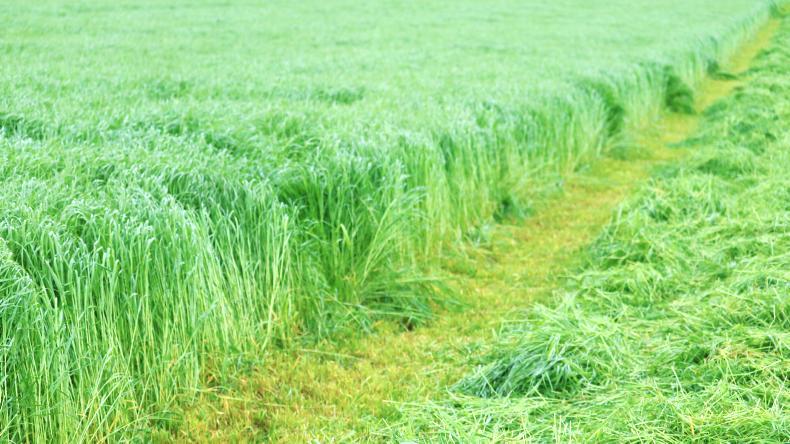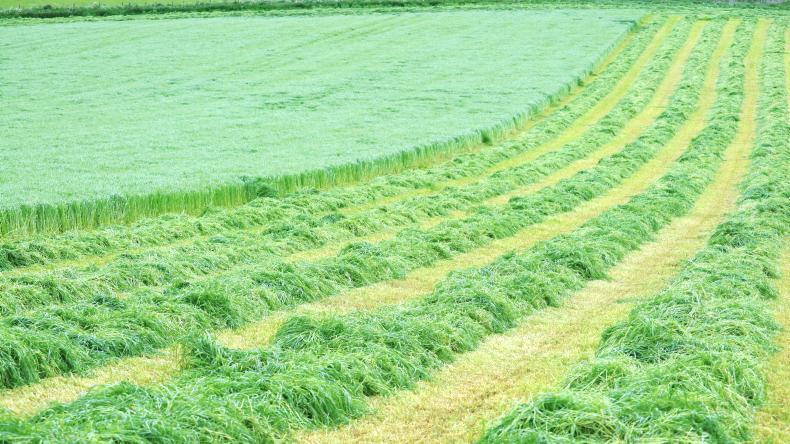The ability for most farmers to reseed this autumn will be severely stretched. The severe summer drought and winter feed shortage means that taking land out of production for any period of time is questionable. Yes, there is undoubtedly a long-term benefit from reseeding unproductive pastures, but the short-term feed deficit is more pressing. The general advice is to delay reseeding plans until next year.
However, where land has already been sprayed off, or where arable land is going back to grass, reseeding will still take place. The question then is, should ordinary perennial ryegrass be sown, or should other, higher-yielding grasses be sown? Other farmers are thinking of sowing fast-growing grasses into tillage land as a way of making more silage.
Italian ryegrass, Westerwolds and hybrid varieties were more common in the past, and are still widely used in other countries, but are not widely used in Ireland. The main reason is that their quality, from a grazing perspective, is poor. Italian ryegrass and Westerwolds are more suitable for intensive silage systems that can be cut every four to six weeks under skies that get less rainfall than Ireland. Hybrid grasses are a cross between Italian and perennial ryegrass and have attributes from both parents.
The quality of these high-yielding grasses is good, when cut at the right stage, but quality deteriorates fast after the plant goes to seed. This makes them hard to manage from a grazing point of view, so they are only suitable for a three- or four-cut silage system. The other big issue is persistency. They are high-yielding, but they don’t last long.
Italian ryegrass
According to the Department of Agriculture recommended lists, Italian ryegrass is best suited to short-term leys of two to three years in duration. They have early spring growth, but can be difficult to manage in mid-season because of stemmy regrowth. Italian varieties are suitable for intensive silage production and can also provide useful grazing in the spring and late autumn period. They tend to have low sward densities and are susceptible to poaching under adverse conditions.
There are three Italian ryegrass varieties on the 2018 recommended lists. These are Fabio and Nabucco, both tetraploids and both supplied by Goldcrop. Davinci is a diploid supplied by DLF. There is not much difference in quality or yield between the varieties but Davinci seems to be higher-yielding but lower-quality. Germinal offers the variety Barextra. Dermot Campion from Germinal says that hybrid grasses Aberecho and Abereve will yield the same as Italian ryegrass but are easier to manage.
Looking at the average of the three varieties, the spring yield is around 1.4t/ha. This is what is grown from late October to mid-April and is substantially higher than the average spring yield in the perennial ryegrass trials. However, some perennial ryegrass varieties have a high spring yield such as Moira, which has a spring yield of 1.74t/ha.
In terms of total production, the Italian ryegrasses are way ahead at over 16t/ha, whereas the average of the perennial ryegrass is closer to 10.5t/ha – a substantial difference. However, there is a big difference in quality terms also. The average dry matter digestibility (DMD) of the Italian ryegrasses is about 78% whereas it is around 85% for the perennial ryegrass swards. However, the cutting protocol is slightly different between the two types, as the Italian ryegrass plots are cut six times (general purpose), while the perennial ryegrass plots are cut eight times (simulated grazing).
Westerwolds
These are an annual version of Italian ryegrass. They are not tested in the Department of Agriculture recommended lists trials. They tend to have an even more vigorous growth pattern than Italian ryegrass and go to seed a lot more frequently so maintaining quality can be an issue.
DLF has two varieties on offer – Peleton and Angus, while Goldcrop recommends the variety Liquattro and Germinal has varieties from Barenbrug. In terms of yield potential, over the course of a year a crop of Westerwolds should yield between 15t DM/ha and 20t DM/ha. The quality of the first cut is usually the highest at around 71% DMD, while subsequent cuts are lower at 66% DMD.
The fact that the quality is lower and the need to reseed every year is a big drawback of Westerwolds. As a short-term measure to produce feed over the winter, they are a good option.
What about the yield potential of both Italian and Westerwolds this winter? If the grass was sown on 10 August, you would expect there to be a cover of about 1,000kg/ha on it by 10 October – 60 days after sowing. If the grass grows 30kg/day for the next month, there would be a cover of 2,000kg/ha on it by mid-November. If the crop is harvested then, it would need to grow 17kg/day on average for there to be a cover of 2,000kg on it by mid-March.
How feasible this is depends on the weather, both for growing the crop and harvesting it. Wet weather at the winter harvest will cause increased losses and reduce subsequent growth rate if damage is done while harvesting. For this reason, it should only be sown on dry, free-draining land which will make harvesting easier and increase the growth potential of the grass.
Delaying sowing into later August will reduce the yield potential which increases the cost per kilo of the grass.
Dave Barry from Goldcrop reckons it will cost in the region of €170/acre to sow Italian ryegrass or Westerwolds. Of this, tilling and sowing will cost €55/acre, fertiliser and spreading costs will be €70/acre while the seed will cost around €45/acre. On fertiliser, Dave recommends 2.5 to three bags/acre of 24:2.5:10 at sowing and a bag of urea/acre in January, but it depends on what is allowed in the farm’s nutrient management plan.
If the crop yields 4t/DM/ha it will cost 10.5c/kgDM to grow it, before land and harvesting costs are included. But if the crop of grass only yields 3tDM/ha it will cost 14c/kgDM just to grow it. At this stage, I would say that a 4t/ha crop is ambitious.
In terms of harvesting, making silage is probably the easiest and best option. There is not much difference in cost between making bales and zero grazing. The trouble with zero grazing in winter and spring is that the weather will be very variable so there will be days where it might not be possible to cut the grass without doing severe damage whereas bales can be made on a fine day. However, because sugars will be low in winter, an additive may be required and this will increase cost.






 This is a subscriber-only article
This is a subscriber-only article










SHARING OPTIONS: